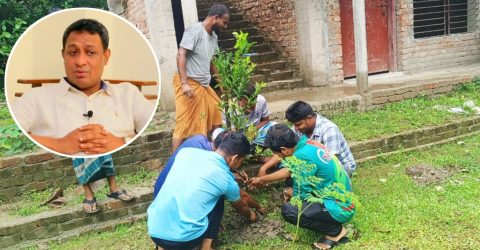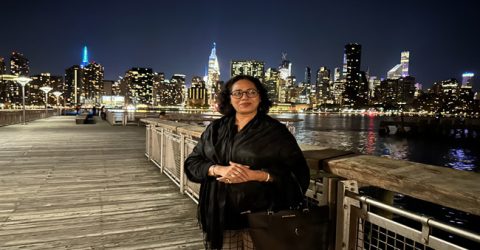With climate change, beautiful childhoods are changing, turning into child labor
The Bangladesh The Bangladesh
Today

Pinky Akter : Emdadul is playing Latim on the green field. Sometimes jumping in the river and swimming with friends. No, it’s not but in reality! When 10-year-old Emdad’s little body gets tired from working all day in a tire shop, he plunges into such memories. Imdad’s family used to live on the banks of the Meghna. Then his family moved to the city. Currently, Imdad’s family lives in Karail Basti. Little Imran had to catch up with the situation of the family at the age of studying for a living. Many families like Imdad lost everything in the river and migrated to the city. Most of them came to slums in the city. Some children are separated from their families and end up begging or living a nomadic life. Where there is no guarantee of basic needs. Due to global warming and climate change, storm-floods and landslides have increased in the entire low-lying areas of Bangladesh including South Bengal. As a result, thousands of families have been displaced from these areas. Being forced to live an inhumane life in the slums of Dhaka. Children of refugee families are also in dire straits due to climate change. Many of them have had their studies stopped forever. Although child labor is banned, many are involved in the work.
According to a report published by the United Nations Children’s Fund, UNICEF, children in three South Asian countries are at extreme risk due to climate change. The countries are Bangladesh, Afghanistan, and India. And nearly 1 billion children in 33 countries around the world are at such extreme risk. According to agency officials, extreme weather conditions, particularly droughts, floods, and riverbeds, have left millions of children homeless in South Asia. They are in dire need of food, healthcare, and clean water. In many cases, these children are forced to drop out of school. Being denied the right to education. About 40 percent of the country’s total population is children. Therefore, many analysts think that these children have to pay the price due to climate change and disasters. According to UNICEF, most children in urban slums do not attend primary school. And children in disaster-prone areas have even fewer opportunities to go to school. According to the organization’s research, about 17 lakh children are engaged in prohibited and hazardous labor in the country. One in four of them is 11 years old or younger. Many girls work as domestic workers. It is difficult to add them to accurate data and story research.
Doing so will increase the number. Most of the children living in the slums work in tanneries, launch yards, bus helpers, automobile factories, and many other risky jobs. Many work as fruit and vegetable market pullers and as porters at bus stands, launch ghat,s or railway stations. The reality is more difficult for girl children, some of them work as housemaids, jobs in fragments, catering in hotels. Some are separated from their families and come to the city and fall into the clutches of brokers and are trafficked, becoming sex workers. Most of them came to Dhaka as refugees from various disaster-prone districts. Experts believe that the physical and mental development of these children is hindered due to joining work at a young age. Their future prospects are being blocked. The lives of these children are falling into a vicious cycle of poverty. This is what the director of ILO’s Bangladesh office, Tumo Pottinen, says.
On the other hand, a UNICEF representative in Bangladesh Sheldon Yate said that children are paying the price of climate change. Human rights activist Wahida Banu said that public and private NGOs should work collaboratively to protect children. Budget allocation should be child friendly along with transparency and accountability only then it is possible to prevent child labor by 2025 Child laborers in Bangladesh are involved in about 347 types of economic activities. Bangladesh government has already identified 42 types of work as hazardous and 13 types of work as extremely hazardous. Bangladesh Labor Foundation (BLF) informs that 47 percent of the workers working in 9,500 small and large factories in Keraniganj of Dhaka are below 17 years of age. The number of children in the age group of 5 to 14 years is about 20 thousand and the number of children in the age group of 5-17 years is about 120 thousand. Farah Kabir, Country Director of Action Aid, said that it is not possible to prevent child labor by enforcing the law alone. Climate change is a global problem so it must be solved globally. But climate change trust funds should be used properly to protect children. Besides, she advised the government to take various initiatives to resettle the children who are moving toward the city. Mohammad Ejaz, Chairman of River and Delta Research Center said, people used to live in houses, lost cropland and moved towards cities due to river erosion. Then the future of the child in the family becomes uncertain and therefore the government should help these refugee families, then it is possible to stop child labor along with child labor.




